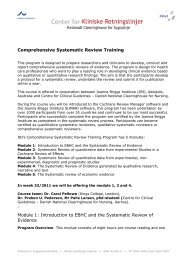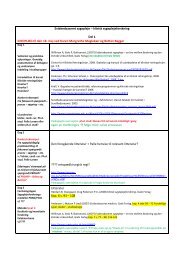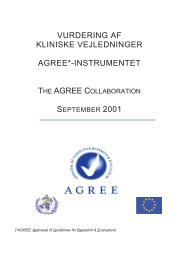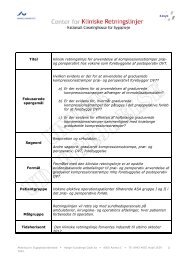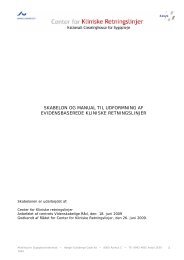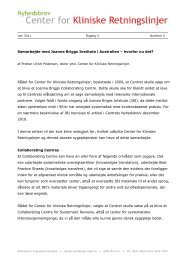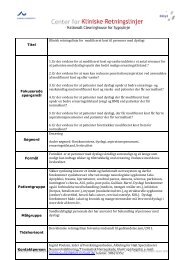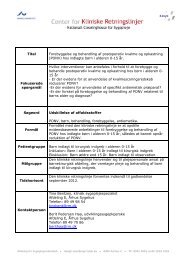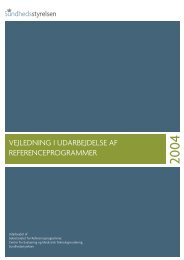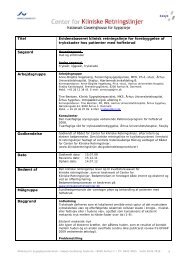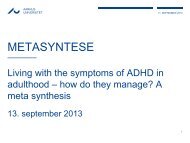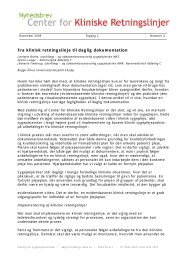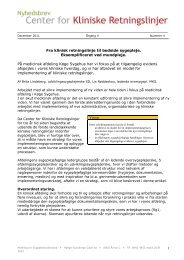Tidlig opsporing af kritisk sygdom hos voksne patienter - Center for ...
Tidlig opsporing af kritisk sygdom hos voksne patienter - Center for ...
Tidlig opsporing af kritisk sygdom hos voksne patienter - Center for ...
You also want an ePaper? Increase the reach of your titles
YUMPU automatically turns print PDFs into web optimized ePapers that Google loves.
AnbefalingerReferencer at der <strong>for</strong>etages systematisk observation <strong>af</strong> vitale værdier <strong>hos</strong> alle <strong>patienter</strong> med henblik påtidlig <strong>opsporing</strong> <strong>af</strong> <strong>kritisk</strong> <strong>sygdom</strong> [6, 7, 9-10, 14-23]Evidensstyrke A at der udvikles og anvendes standardiseret beslutningsstøtte [26]Evidensstyrke C at observationer indføres i ét standardiseret gr<strong>af</strong>isk system mhp. [11, 13, 26,27, 30]o ensartet registrering <strong>af</strong> alle <strong>patienter</strong> [21]o øget registreringsfrekvens [21]o øget relevant og tilstrækkelig reaktion på <strong>for</strong>værring <strong>af</strong> patientens tilstand vurderet påvitalværdier og/eller score [10, 21]Evidensstyrke B at der anvendes entydig kommunikation faggrupper imellem om <strong>patienter</strong>nes fysiologiskestatus (evt. ved anvendelse <strong>af</strong> scoresystem) [25]Evidensstyrke C at personale er uddannet io observation <strong>af</strong> vitale værdier [4, 6, 8, 27]o scoring <strong>af</strong> vitale værdier [6, 8, 15, 21, 27]o dokumentation <strong>af</strong> vitale værdier [8, 14, 27]o handling på observerede vitale værdier [3, 4, 6, 8, 25, 27, 29]Evidensstyrke A at observations- og scoresystemer ikke anvendes som erstatning <strong>for</strong> densundhedsprofessionelle viden og erfaring, men som supplement til ”Det kliniske blik” [7, 30,32]Evidensstyrke AAnbefaling: Alle <strong>patienter</strong> scores mindst en gang i døgnet med mindre andet er ordineret.Indikator: Andel <strong>af</strong> scorede <strong>patienter</strong> samt <strong>patienter</strong>,hvor årsagen til manglende score er anført.Standard: 95%3. Main DS, Henderson WG, Pratte K et al. Relationship of processes and structure of care in general surgery to postoperativeoutcomes: A descriptive analysis. J Am Coll Surg 2007;204:1157-65 C lll4. Fuhrmann L, Lippert A, Perner A et al. Incidence, st<strong>af</strong>f awareness and mortality of patients at risk on general wards.Resuscitation 2008;77:325-30 B llb6. www.operationlife.dkhttp://www.operationlife.dk/Kampagnemateriale/~/media/OL/pdf/vejledning_mobilt%20akut%20team_version2%20%200_juni08.ashx nov 2008 D lv7. Smith GB, Prytherch DR, Schmidt PE et al. A review, and per<strong>for</strong>mance evaluation, of single-parameter “track and trigger”systems. Resuscitation 2008;79:11-21 A la8. McGaughey J, Alderdice F, Fowler R et al. Outreach and Early Warning Systems (EWS) <strong>for</strong> the prevention of intensive careadmission and death of critically ill adult patients on general <strong>hos</strong>pital wards (Review) . The Cochrane Library 2008;4:1-22 A la9. McQuillan P, Pilkington S, Allan A et al. Confidential inquiry into quality of care be<strong>for</strong>e admission to intensive care. BMJ1998;316:1853-58 B llb10. Goldhill DR, Worthington L, Mulcahy A et al. The patient-at-risk team: identifying and managing seriously ill ward patients .Anaesthesia 1999;54:853-60 C lll11. Paterson R, MacLeod DC, Thet<strong>for</strong>d D et al. Prediction of in-<strong>hos</strong>pital mortality and length of stay using an early warningscoring system: clinical audit. Clin Med 2006; 6:281-84 B ll13. Gao H, McDonnell A, Harrison DA et al. Systematic review and evaluation of physiological track and trigger warning systems<strong>for</strong> identifying at-risk patients on the ward. Intensive Care Med 2007;33:667-79 A la14. Smith GB, Prytherch DR, Schmidt P et al. Hospital-wide physiological surveillance—A new approach to the earlyidentification and management of the sick patient. Resuscitation 2006;71:19-28 C lll15. Buist M, Bernard S, Nguyen TV et al. Association between clinically abnormal observations and subsequent in-<strong>hos</strong>pitalmortality: a prospective study . Resuscitation 2004;62:137-41 B llb16. Cuthbertson B, Boroujerdi M, McKie L et al. Can physiological variables and early warning scoring systems allow earlyrecognition of the deteriorating surgical patient?. Crit Care Med 2007;35:402-9 B llb17. Duckitt RW, Buxton-Thomas R, Walker J et al. Worthing physiological scoring system: derivation and validation of aphysiological early-warning system <strong>for</strong> medical admissions. An observational, population-based single-centre study . Br JAnaesth 2007;98:769-74 C llI18. Giuliano KK. Continuous physiologic monitoring and the identification of sepsis . AACN Adv Crit Care 2006;17:215-23 D lv19. Giuliano KK. Physiological monitoring <strong>for</strong> critically ill patients: Testing a predictive model <strong>for</strong> the early detection of sepsis.Afdeling <strong>for</strong> Sygeplejevidenskab • Høegh-Guldbergs Gade 6a • 8000 Aarhus C • Tlf: 8942 4855 mobil 2639 7839



